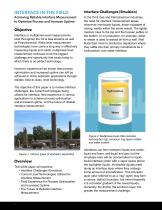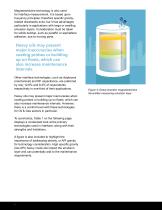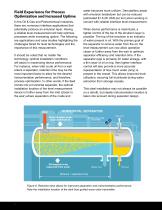 Website:
Magnetrol - AMETEK
Website:
Magnetrol - AMETEK
Group: AMETEK
Catalog excerpts

Achieving Reliable Interface Measurement to Optimize Process and Increase Uptime A Magnetrol® Level Matters Series White Paper
Open the catalog to page 1
Achieving Reliable Interface Measurement to Optimize Process and Increase Uptime Objective Interface or multiphase level measurements exist throughout the Oil & Gas streams as well as Petrochemical. While level measurement technologies have come a long way in effectively measuring liquids and solids, multiphase level measurement continues to be the biggest challenge and opportunity that exists today to which there is no perfect technology. Interface Challenges (Emulsion) In the Oil & Gas and Petrochemical industries, the need for interface measurement arises whenever immiscible liquids,...
Open the catalog to page 2
While monitoring the top, or total level, is critical for safety and overfill prevention, knowing the level of an interface is necessary for maintaining product quality and operations efficiency. If there is water in oil that is not separated effectively (water carryover), then this can induce processing problems, equipment failures and unplanned shutdowns. If there is oil in water (oil extraction), then there can be production loss, environmental fines, penalties and forced shutdowns. Of all the level switches and transmitters available, only a handful are suitable for reliable interface...
Open the catalog to page 3
Magnetostrictive technology is also used for interface measurement. It is based upon buoyancy principles, therefore specific gravityrelated drawbacks exist, but it has advantages particularly in applications with large or swelling emulsion layers. Consideration must be taken for solids buildup, such as paraffin or asphaltene adhesion, due to moving parts. Heavy oils may present major inaccuracies when coating probes or building up on floats, which can also increase maintenance intervals. Other interface technologies, such as displacers (mechanical) and RF capacitance, are preferred by only...
Open the catalog to page 4
Interface Level Technology Comparison Technology Guided Wave Radar Measurement -Tracks top level and near top of emulsion layer -Low dielectric top level and high dielectric bottom level -Direct level measurement, even in low dielectrics, versus inferred (some GWR and other technologies) Tracks near middle or average of emulsion layer -Buoyancy forces change with liquid type -Buildup detection and diagnostics -Less maintenance (no moving parts) -Overfill prevention (total level measurement) -Buoyancy-based floats weighted for different levels, including total level and particularly bottom...
Open the catalog to page 5
Transmitter Comparison by Oil SG/API Transmitter Comparison by Oil SG/API API° Heavier Oils with Thicker Emulsion Layers Medium to Light Oils F igure 5: Magnetrol recommendations with buoyancy-based technologies (displacer and magnetrostrictive) on the left for heavier oils with thicker emulsion layers, and GWR on right for medium to light oils. Note that these are general guidelines and there is overlap between technologies that may vary from this illustration. Consult Magnetrol for best technology-to-application match.
Open the catalog to page 6
Field Experience for Process Optimization and Increased Uptime In the Oil & Gas and Petrochemical industries, there are numerous interface applications that potentially produce an emulsion layer. Having a reliable level measurement will help optimize processes while increasing uptime. The following are applications and case studies highlighting the challenges faced for level technologies and the importance of this measurement. It should be noted that no matter the technology, optimal installation conditions will assist in maximizing device performance. For instance, when inlet crude oil...
Open the catalog to page 7
What is important to consider in any application, regardless of whether it is interface or total level, is what can occur during upset conditions or startup and shutdown. Most devices may work fine in normal interface operation; however, reliable measurement is required in those upset cases as well: • hen only one liquid exists W (only water or only oil) • When chamber is flooded (only oil and water – no gas phase exists) • Multiphase oil, water and gas including overfill prevention The first industry that comes to mind when discussing interface is upstream Oil & Gas or exploration and...
Open the catalog to page 8
Cost The oil-water separation in the gun barrel separator and any downstream unit is critical. If oil carries over into the disposal well then it can damage or plug the well, requiring rework costs and downtime as well as an increase in chemical costs used in the treatment process. The oil-water separation in the gun barrel separator and any downstream unit is critical. Having a clearer understanding of the day-today storage of “unwanted” liquids in the tank battery (pending disposal) versus production capacity allows for better management and utilization of resources, such as trucks...
Open the catalog to page 9
The result of ineffective boot interface measurement can range from reduced productivity and process efficiency to catastrophic failures in downstream equipment. The ECLIPSE Model 706 GWR transmitter is an ideal solution for boots, often accompanied by a magnetic level indicator (MLI) for visual indication. Sight glasses and MLIs are prevalent in refineries for manual inspection and walk through. If trace water particles arrive downstream it may only cause minor maintenance or cleanup over time. Conversely, if a slug of water is not separated and eventually enters distillation columns or...
Open the catalog to page 10
INTERFACE APPLICATION CASE STUDY #3 Petrochemical Loss of Primary Containment (LOPC) Situation One of the world’s largest oil & gas and petrochemical companies headquartered in Europe was having issues with multiphase level measurement involving a hydrocarbon with water bottoms and a gas vapor space. GWR was being utilized, but the existing device did not produce a reliable signal throughout the length of the probe and the interface made it difficult to distinguish between the upper level and water bottom. Direct cost of a workrelated death is $1M USD and indirect costs are approximately...
Open the catalog to page 11All Magnetrol - AMETEK catalogs and technical brochures
-
Emulsion In The Field
9 Pages
-
PRODUCT LINE CATALOGUE
106 Pages
-
Aurora® Magnetic Level Indicator
28 Pages
-
Atlas™ Magnetic Level Indicator
24 Pages
-
STEAM DRUM LEVEL MATTERS
1 Pages
-
INTERFACE IN THE FIELD
1 Pages
-
Echotel® 355
4 Pages
-
Echotel® 335
4 Pages
-
Power Generation
16 Pages
-
Petroleum Refining
16 Pages
-
Natural Gas Processing
12 Pages
-
Seal Pots
4 Pages
-
Mass Flow Measurement
12 Pages
-
Interface Level Measurement
8 Pages
-
Heat Rate Awareness
8 Pages
-
Ethylene Applications
8 Pages
-
Thermatel® TD1/TD2
16 Pages
-
Kotron® 082
4 Pages
-
Enhanced Jupiter®
16 Pages
-
GEMINI™
32 Pages
-
Aurora®
32 Pages
-
Atlas™
24 Pages
-
Horizon TM Model 704
8 Pages
-
Eclipse® Enhanced 705 Hygienic
12 Pages
-
Eclipse® Enhanced 705
8 Pages
-
Pneumatic Tuffy®
12 Pages
-
Models T5x & T6x
8 Pages
-
Models T20/T21
12 Pages
-
Series B73 and Series 75
12 Pages
-
Series 3
24 Pages
-
Model J52
2 Pages
-
Model B40
4 Pages
-
TUFFY® II
12 Pages
-
Digital E3 Modulevel®
12 Pages
-
Floating Roof Detection
16 Pages
-
APM Pneumatic Modulevel®
12 Pages
-
Flue Gas Desulferization
8 Pages
-
Energy Management
4 Pages
-
API 2350 Overfill Prevention
8 Pages
-
PULSAR ® R96
1 Pages
-
Water & Wastewater
12 Pages
-
Displacer Switches
20 Pages
-
Displacer Transmitters
4 Pages
-
Guided Wave Radar
12 Pages
-
Magnetic Level Indicators
12 Pages
-
Magnetostrictive
16 Pages
-
Pulse Burst Radar
8 Pages
-
Thermal Dispersion
12 Pages
-
Ultrasonic Contact
4 Pages
-
Vibrating Rod Switches
4 Pages
-
R Series High Temp Switch
12 Pages
-
Series K Pneumatic Switch
8 Pages
-
J Series Pneumatic Switch
8 Pages
-
Liquid Displacer Level Switches
16 Pages
-
Crude Oil Processing
8 Pages
-
Product Line Quick Reference
8 Pages





























































































